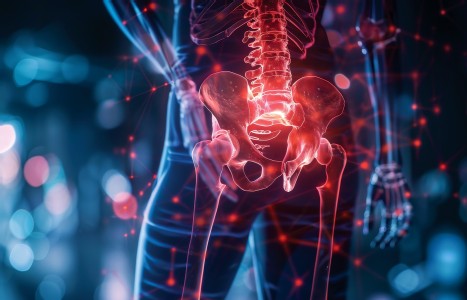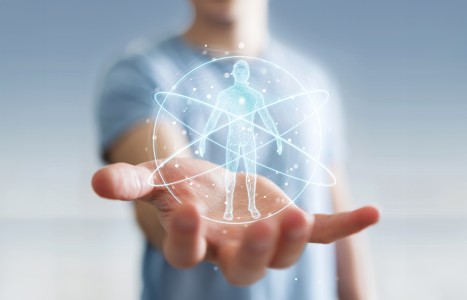Pelvic pain has a prevalence of >25% in women and >15% in men, and up to 50% of cases are undiagnosed, demonstrating that there is a definite need for pelvic care awareness among health care practitioners. As holistic practitioners, acupuncturists offer a safe space for clients and are often the practitioners clients seek out when nothing else has worked. Thus, acupuncturists are presented with an opportunity to serve an underserved population.
Abdominal Acupuncture for Eye Healing: The Sacred Turtle and Ba Gua Map
Our ideas about western medicine have shifted in recent decades, while the public is asking more from health care providers. The old method of referring each symptom to a particular specialist isolated from the whole person has been replaced slowly with alternative forms of health care like acupuncture and Chinese herbal medicine. In the perspective of TCM, we are looking at the whole person, his or her dietary preferences, life style, exercise, and connections to different types of relationships, as well as particular symptoms and signs which brought them in for treatment in the first place.
We believe our vision does not happen in a vacuum. Rather it has its roots in our total being. The body does not work as a series of parts in isolation, but as a whole, dynamically integrated with our whole system. Every cell is a nerve cell. This biological awareness of every cell is really the foundation of vision. Each of us is unique and literally takes in the world primarily through our vision; moreover, the way we take in the world is, to some degree, a reflection of who we are and which symptoms we might manifest.
Most eye problems respond to acupuncture. In some cases this may come as a surprise. Acupuncture can be effective in treating a wide range of conditions of eye disorders. For some conditions, such as macular degeneration, diabetic retinopathy, retinitis pigmentosa, Stargardt's disease and other degenerative disease, which have no treatment in western medicine and acupuncture is the treatment of choice. For other diseases, such as conjunctivitis, corneal ulcer, keratitis, retinal vein or artery obstruction, optic neuritis, optic atrophy, cataract (in the early stage) and chronic (open-angle) glaucoma, acupuncture can be beneficial as a supplementary therapy. Acupuncture will change the patient's overall condition so that both the symptoms and the underlying disharmony disappear. The body may be supported sufficiently to remove all unpleasant symptoms.

Your eyes are a reflection of your overall health. Illnesses such as diabetes, cardiovascular disease or digestive disease can be revealed in the eyes at a very early stage, recent medical studies suggest there is a positive correlation between digestive disorders and degenerative eye diseases. Conditions such as glaucoma, macular degeneration, optic neuritis, vision loss and other degenerative eye problems are often associated with systemic health problems. Eye conditions respond well to acupuncture and it has been used successfully to treat a wide range of eye problems for centuries in China. Oriental medicine pays close attention to the relationship between channels and organs. Sometimes an imbalance within the body can manifest as an eye problem, just as the health of the eyes is often a reflection of an imbalance or health problem elsewhere in the body.
Abdominal acupuncture (map of the Sacred Turtle and the Ba Gua map), including the Shen Que (Ren 8) channel system, the use of abdominal acupuncture to harmonize the Zang Fu, treat illness and strengthening the Yuan Qi is based on ancient theories of Daoism. In the past, old qigong masters imagined a three cun taiji (yin/yang) symbol centered below the umbilicus. Embraced in the center were two energy systems, one yang and one yin. Forming this they produced the yin and yang, the ascending/descending, the entering/exiting of qi and blood throughout the body.
The formation of the embryo is regularized by the umbilical system and this system controls the whole organism during the period of pregnancy. The network of pathways transports qi and blood from the mother to the fetus during gestation. Normal fetal development relies on the transportation and modulation of these essential substances from the mother before the fetus's own zang fu organs produce them by themselves. After birth, this system gradually integrates with the postnatal system whose qi and blood generated from food essence by internal Zang Fu Organ. This considers the first system of regulation and the basis of the meridian system and the distribution of qi and blood of the whole body forming a macroscopic control. Because most of the organs or their external-internal pair resides in the abdomen, needling the abdominal points can affect the entire internal organ. This is an advantage by comparing distal points on the extremities because it is not always easy for transmission of the stimulation from distal points to reach the organs, especially when there is a node-block (possibility of blocked pathways) high up along the pathway that may require protracted periods of manipulation or additional needling to release the blocks.
The abdomen is recognized as our second brain. In ancient times, the abdomen was used for diagnosis, today the abdomen is used to treat the entire body. The abdomen has more nerve cells than the brain and spinal cord combined. As a result, it has huge control over our emotional well being, as well as our overall health and is particularly important in the regulation of digestion. The abdomen produces about 80% of all serotonin, a hormone responsible for mood, sleep, learning and blood pressure. Abdominal acupuncture therefore has far reaching effects on digestive and degenerative problems and also helps with relieve depression and sleep disorders. By needling abdominal points, you may feel a general warm radiating feeling or if you are very in tune with your body, you may feel a qi sensation in the relevant part of the body being worked on, such as the arm, leg or back rather than the area of the abdomen being treated.
The abdominal regulation system is divided into three different systems: the superficial layer (heaven level) is pictured as a hologram of a turtle; all its parts correspond to the human body. The turtle's head is centered at Ren 12; with its ears on the kidney channel, just lateral to Ren 12. The neck and throat is on a line between Ren 11 and Ren 10. The edge of the abdomen is at ST 25, and the shoulders are at ST 24. The elbow is situated above the shoulder 0.5 cun laterally. The wrist is just inferior to the elbow and lateral 0.5 cun. The upper limb forms an inverted V. The hand is represented as a fist just beyond the wrist with the thumb up. The lower portion of L1 is at Ren 6, the coccyx is at Ren 3, and the hip at ST 26. The knee is 0.5 cun lateral and inferior to the hip. Another knee point is halfway between Ren 6 and the primary one. All three points lie on the same horizontal line. The ankle is lateral to the knee and 0.5 cun inferior. The foot is just beyond this, with the toes 45 degrees inferior and medial to the foot. All parts of the body can be fond in this system, and it is frequently used for musculoskeletal problems, anxiety, depression, arthritis, cataract, glaucoma, Parkinsonism and diabetic neuropathy are also helped with this layer. For patients with eye problems, adding KI 17, KI 18 and KI 19 to guide qi to the neck and head, since most eye disorders are caused from poor blood circulation, which clinical manifestation accompanied with neck and shoulder stiffness and tightness, particularly KI 18, represent the third cervical vertebrate, where most of arteries and nerves responsible for vision are located. There are also eye points on the turtle map, 0.5 cun lateral and 0.3 superior to Ren 12, which directly bring qi and blood to the eyes.
The medial layer (humanity level), it is the connection between the superficial and deep level. This layer consist points of the extraordinary vessels on the belly. Mental or spiritual disorders and traumas can be addressed in this level. The deeper layer (Earth level) is called the Zang Fu organs system, represented by the Ba Gua map. The layout of the organs matched the post-heaven (later heaven) Eight Trigrams (Ba Gua) from the Book of Changes (I Ching). There are eight points representing different elements or different Zang Fu organs, each point has its specific therapeutic function and is chosen for the long-term chronic disorders. Especially degenerative eye problems respond very well with this system.
The sequence of the trigrams in Hou Tian Bagua, also known as the Bagua of King Wen or Later Heaven Bagua, describes the patterns of the environmental changes. Kan is placed downwards and Li at the top, Zhen in the East and Dui in the West. Contrary to the Earlier Heaven Bagua, this one is a dynamic Bagua where energies and the aspects of each trigram flow toward the following. It is the sequence used by the Luo Pan (compass) which is used in Feng Shui to analyze the movement of the qi that affects us.
According to this system, the diagram Li corresponds to Fire, Heart (RN 12). The diagram Kun corresponds to the Earth, Spleen (Ab1 Left, Upper rheumatic point, 0.5 cun lateral and superior to St 24). The diagram Dui corresponds to the Lake, Lung (SP15 Left). The diagram Qian corresponds to the Heaven, Small intestine (Ab 4 Left, lower rheumatic point, 0.5 cun lateral and inferior to ST 26). The diagram Kan correspond to the Water, Kidney (RN 4). The diagram Gen corresponds to Mountain, Large intestine (Ab 4 Right). The diagram Zhen corresponds to the Thunder, Liver (SP15 Right) and the diagram Xun corresponds to the Wind, Stomach (Ab1 Right). For eye problems, Ab 4(R) and Sp 15 (L) are paired to treat wet type macular degeneration by resolving damp and phlegm. Ab 4 (R) it self can help stop bleeding, releasing pain for various kinds of eye problems. Ab 1 (R) can treat optic nerve disorders and blood vessel disorders in the retina. Ab 1 (L) can treat degenerative eye problems with digestive disorders.
Abdominal acupuncture can only be achieved with ideal effect through deep understanding and years of practice of the theory, philosophy and techniques which is quite unique and different to the regular acupuncture method. The arrival of qi is felt by the practitioner, not always necessarily from the patients. This requires sensitivity to needle sensation that must be trained with an experienced mentor.
Case Study
A 53-year-old male patient with retinal bleeding and retinal arterial occlusion. Poor left eye vision due to arterial occlusion. Laser treatment was unsuccessful and caused more bleeding. He had relatively good vision in the right eye, slightly hazy and getting worse. Lost some upper field of vision, retina picture showed blood clots. Insomnia, high blood pressure, heartburn, acid reflux, burping and constipation. Wiry pulse, red and dusky tongue with large cracks and peeled coating, BP was reported to be 150/80. According to the TCM, his diagnosis was Heart and Kidney disharmony and Liver Yang rising.
He received abdominal acupuncture at the following points: Ren 12, Ren 10 to tonify post heaven qi and balance Fire, Ren 4, Ren 6 to tonify pre heaven qi and balance water. These four points together guiding qi to the source, it can promote the acquired essence to strengthen and benefit the congenital essence, invigorate the spleen and tonify the kidney. KI 18 corresponds to the neck and will help ascending qi to the neck and eye, ST 24 and ST 26 (Abdominal Four Gates), promote the circulation of qi and blood, dredge meridians and distribute zang fu organ qi through the body. Together these points with ST 25 can regulate the spleen and stomach. Gen diagram to respond mountain element representing stop and pacify effect so as to stopping bleeding. Point abdominal Ren Zhong (0.3 cun superior to Ren 12), which is similar to DU 26, to reduce the Liver Yang and sedate the Shen.



